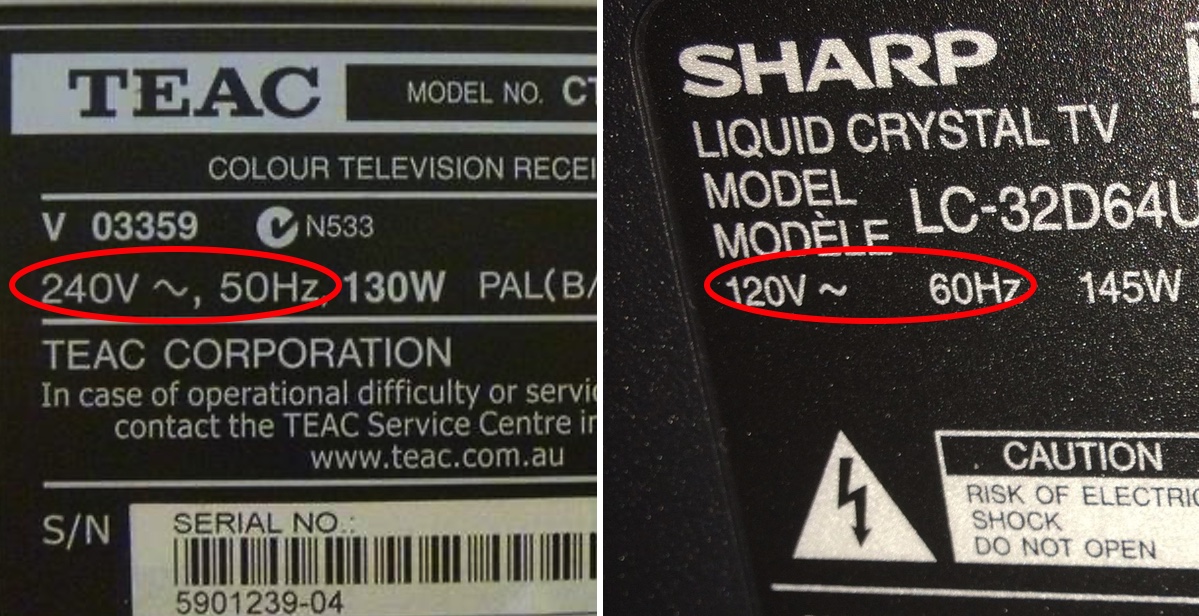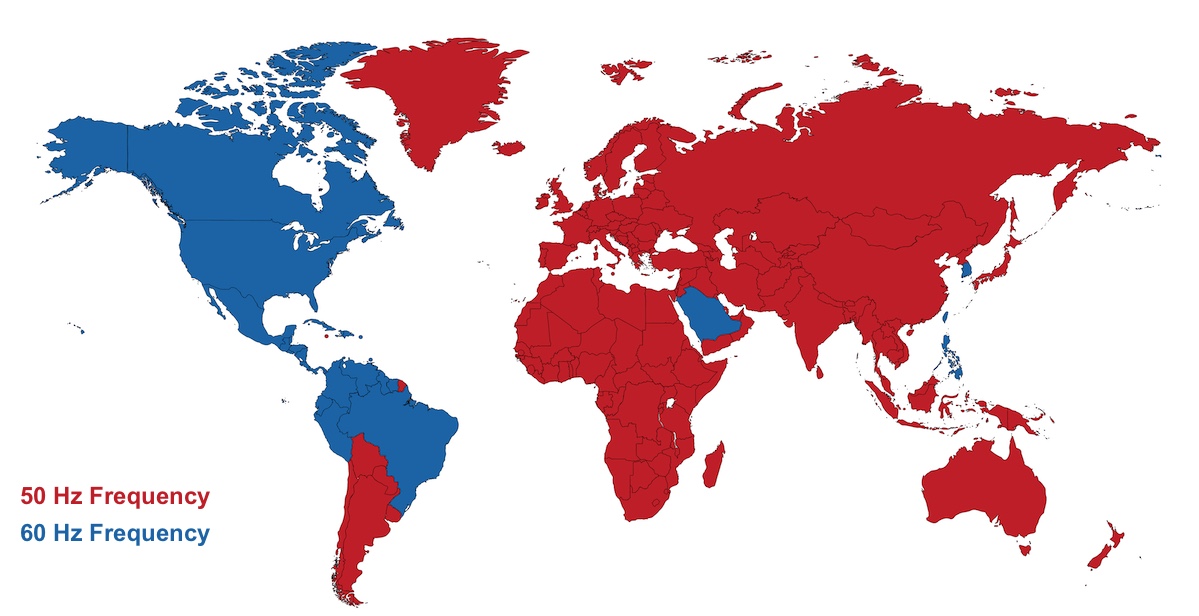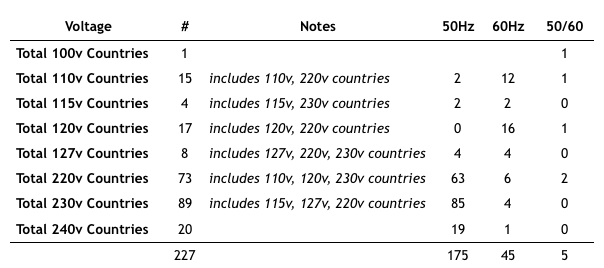World Electricity
An Incompatible Global Electrical Grid
The differences in power line electricity

Have you ever look at the back of your home appliances? Have you ever notice there is a label with wall plug electricity requirement on it?
Most of the people don't realize the electricity that we use every single day is different from country to country. Also, most the people don't know the home appliances that we use everyday are built differently from country to country, especially the electricity requirement.
Look at the above image which shows you the difference of electrical power requirement. One requires to have a 120 volt / 60 hertz (the right one) wall plug power, another one requires to have a 240 volt / 50 hertz power input.
A lot of us don't aware the differences in electricity until you are moving overseas and bringing your appliances with you. Or you own a boat, and it generates the 220V to 240V 50Hz power and you want to use 120V 60Hz appliances on your boat.
120V Vs 220V | 50Hz Vs 60Hz

So, why do we need the voltage and frequency differences on the electrical power grid?
The utility frequency, also known as power line frequency (American English) or mains frequency (British English) is the nominal frequency of the oscillations of alternating current (AC) in an electric power grid transmitted from a power station to the end-user. In large parts of the world this is 50 Hz, although in the Americas and parts of Asia it is typically 60 Hz.
During the development of commercial electric power systems in the late-19th and early-20th centuries, many different frequencies (and voltages) had been used. Large investment in equipment at one frequency made standardization a slow process. However, as of the turn of the 21st century, places that now use the 50 Hz frequency tend to use 220–240 V, and those that now use 60 Hz tend to use 100–127 V. Both frequencies coexist today (Japan uses both) with no great technical reason to prefer one over the other[1] and no apparent desire for complete worldwide standardization.
In practice, the exact frequency of the grid varies around the nominal frequency, reducing when the grid is heavily loaded, and speeding up when lightly loaded. However, most utilities will adjust the frequency of the grid over the course of the day to ensure a constant number of cycles occur. This is used by some clocks to accurately maintain their time.
The problem in 50Hz Vs 60Hz

Today, there are 175 countries that have a 50Hz frequency and 45 other countries that use 60Hz.
Within the two frequency groups, there are numerous voltages:
For an American manufacturer of electrical equipment, including home appliances designed to operate at 120v 60Hz, this difference in voltage and frequency has severely restricted their ability to compete in the global marketplace without a costly and fundamental dedication to manufacturing goods that meet each countries specific electrical grid specification.
For owners of electrical equipment that are exclusively designed to operate at 60Hz, moving and relocating to a country that uses 50Hz as its electrical grid frequency has been an insurmountable barrier.
Unless specified by the manufacturer to operate on both 50Hz and 60Hz, appliances may not operate efficiently or even safely if used on anything other than the intended frequency. Not only do they operate incorrectly and frequently face catastrophic failure, the clocks run slower while the motors run hotter and have a shorter life span. A regular transformer that changes only the voltage does not address the issue of frequency, the root cause of those problems.
Same issue exists for European or other manufacturers whose main markets are operating at 50Hz frequency. Also, owners of electrical products that are designed exclusively to operate at 50Hz, face failures, when they are used in 60Hz countries.
List of Worldwide Electricity Voltages and Frequencies
| Country | Voltage | Frequency |
|---|---|---|
| Afghanistan | 220V | 50Hz |
| Albania | 230V | 50Hz |
| Algeria | 230V | 50Hz |
| American Samoa | 120V | 60Hz |
| Andorra | 230V | 50Hz |
| Angola | 220V | 50Hz |
| Anguilla | 110V | 60Hz |
| Antigua | 230V | 60Hz |
| Argentina | 220V | 50Hz |
| Armenia | 230V | 50Hz |
| Aruba | 127V | 60Hz |
| Australia | 240V | 50Hz |
| Austria | 230V | 50Hz |
| Azerbaijan | 220V | 50Hz |
| Azores | 230V | 50Hz |
| Bahamas | 120V | 60Hz |
| Bahrain | 230V | 50Hz |
| Balearic Islands | 230V | 50Hz |
| Bangladesh | 220V | 50Hz |
| Barbados | 115V | 50Hz |
| Belarus | 230V | 50Hz |
| Belgium | 230V | 50Hz |
| Belize | 110/220V | 60Hz |
| Benin | 220V | 50Hz |
| Bermuda | 120V | 60Hz |
| Bhutan | 230V | 50Hz |
| Bolivia | 230V | 50Hz |
| Bosnia | 230V | 50Hz |
| Botswana | 230V | 50Hz |
| Brazil | 110/220V | 60Hz |
| Brunei | 240V | 50Hz |
| Bulgaria | 230V | 50Hz |
| Burkina Faso | 220V | 50Hz |
| Burundi | 220V | 50Hz |
| Cambodia | 230V | 50Hz |
| Cameroon | 220V | 50Hz |
| Canada | 120/240V | 60Hz |
| Canary Islands | 230V | 50Hz |
| Cape Verde | 230V | 50Hz |
| Cayman Islands | 120V | 60Hz |
| Central Africa | 220V | 50Hz |
| Chad | 220V | 50Hz |
| Channel Islands | 230V | 50Hz |
| Chile | 220V | 50Hz |
| China | 220V | 50Hz |
| Colombia | 110V | 60Hz |
| Comoros | 220V | 50Hz |
| Congo (Zaire) | 220V | 50Hz |
| Cook Islands | 240V | 50Hz |
| Costa Rica | 120V | 60Hz |
| Côte d'Ivoire (Ivory Coast) |
220V | 50Hz |
| Croatia | 230V | 50Hz |
| Cuba | 110/220V | 60Hz |
| Cyprus | 230V | 50Hz |
| Czech Republic | 230V | 50Hz |